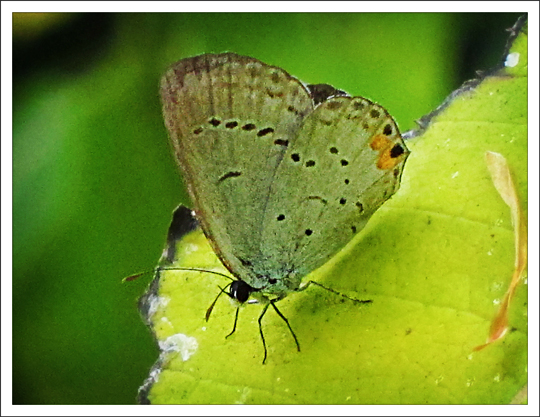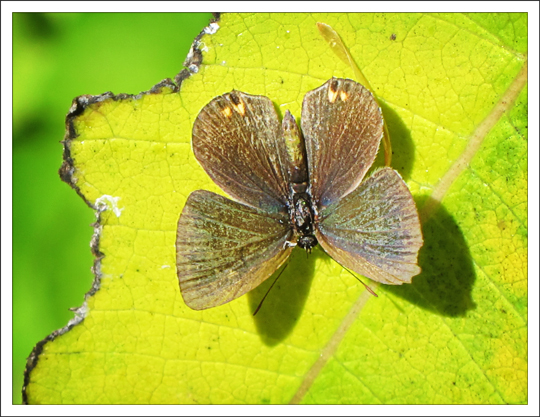Butterflies of the Adirondack Mountains:
Eastern Tailed-Blue (Cupido comyntas)
 Butterflies of the Adirondacks: Eastern Tailed-Blue in the Paul Smiths VIC Butterfly House (9 September 2012)
Butterflies of the Adirondacks: Eastern Tailed-Blue in the Paul Smiths VIC Butterfly House (9 September 2012)
| This page is no longer being updated. For an updated version of this material, see: Eastern Tailed-Blue (Cupido comyntas). |
The Eastern Tailed-Blue (Cupido comyntas) -- also identified as Everes comyntas in some sources [1] -- is a small butterfly that may be seen in the Adirondack Mountains of upstate New York in summer. It derives its name from the narrow tail on the hind wing, which is just visible on these photos. The under side of the hind wing is pale gray with distinct black spots and several orange spots at the outer margin near the tail. [2] [3] [4] Like other blues, Eastern Tailed-Blues are sexually dimorphic. [5] From the top, males are iridescent blue, [6] while summer females (shown here) are brown. Color patterns vary by season. [7] In the spring, some females have blue at the base of the wings. [8] The wing span is 3/4 inch to 1 inch. [9] This butterfly is often mistaken for an Azure or a Silvery Blue.
Male Eastern Tailed-Blue butterflies patrol near the host plants during the day time. Females lay their pale green eggs on flower buds or young leaves. [10] [11] [12] The larva of the Eastern Tailed-Blue is hairy, dark green or various shades of brown. [13] Caterpillar hosts include plants in the legume family. [14] [15] [16] Adult butterflies can be found on flowers close to the ground, including white sweet clover, winter cress, cinquefoils, and asters. [17] [18] [19] Eastern Tailed-Blues sometimes bask with their wings at a 45 degree angle. [20] [21]
 Butterflies of the Adirondacks: Female Eastern Tailed-Blue in the Paul Smiths VIC Butterfly House (9 September 2012)
Butterflies of the Adirondacks: Female Eastern Tailed-Blue in the Paul Smiths VIC Butterfly House (9 September 2012)
From the ecological standpoint, the Eastern Tailed-Blue is a generalist. [22] This butterfly is said to be one of the East's most abundant butterflies, having adapted readily to human activities. [23] [24] [25] Typical habitats of the Eastern Tailed-Blue are open, sunny places, [26] [27] including meadows, forest clearings, disturbed areas, and city lots. [28] [29] Their range includes southeastern Canada and the eastern part of the US, west to Western North Dakota. [30]
The Eastern Trailed-Blue is very common in fields and meadows in this part of the Adirondack Mountains and can be seen throughout the summer, if it's a warm one. [31] [32] In 2012, Eastern Tailed-Blue butterflies were present in the Paul Smiths VIC Native Species Butterfly House from 3 August to 9 September.[33]
References
- Susan Grimm Hanley. Interpretive Naturalist, Paul Smith's College Native Species Butterfly House. Species Logbooks.
- Butterflies and Moths of North American. Species Profiles. Sighting records: 9/9/12; 9/9/12
- Government of Canada. Canadian Biodiversity Information Facility. SpeciesBank.
- Massachusetts Butterfly Club. Massachusetts Butterfly Species List.
- ENature. Field Guides.
- Iowa State University. Department of Entomology. BugGuide. Sighting records: 8/10/08; 8/10/08; 8/17/11; 8/17/11
- National Audubon Society. Field Guide to Butterflies (New York: Alfred A. Knopf, 1981), pp. 491-492.
- Jim P. Brock and Kenn Kaufman. Kaufman Field Guide to Butterflies of North America (Houghton Mifflin, 2003), pp.124-125.
- Paul A. Opler. A Field Guide to Eastern Butterflies (The Peterson Field Guide Series, Houghton Mifflin Company, 1992,1998), pp. 74-75, 214-215.
- Jeffrey Glassberg. Butterflies of North America (Michael Friedman Publishing, 2002), pp. 108-109.
- James A. Scott. The Butterflies of North America. A Natural History and Field Guide (Stanford University Press, 1986), pp. 395-396.
- Donald and Lillian Stokes. Stokes Butterfly Book. The Complete Guide to Butterfly Gardening, Identification, and Behavior (Little, Brown and Company, 1991), pp. 62-63.
- Jeffrey Glassberg. Butterflies through Binoculars. The East. A Field Guide to the Butterflies of Eastern North America (Oxford University Press, 1999), p. 92, Plate 24.
- Paul A. Opler and George O. Krizek. Butterflies East of the Great Plains: An Illustrated Natural History (The Johns Hopkins University Press, 1984), pp. 109, 114-115, Plate 18.
- Rick Cech and Guy Tudor. Butterflies of the East Coast. An Observer's Guide (Princeton University Press, 2005), p. 138.
- David Carter. Butterflies and Moths (Dorling Kindersley, Inc., 1992), p. 93.
